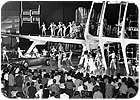
General Motors has a long heritage of participating in world’s fairs. In fact, several of its exhibits proved so popular that the company decided to take the show on the road. Here’s a nostalgic look back at some of GM’s showmanship over the last 75 years.
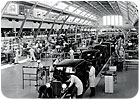
Chevrolet sedans roll down an assembly line at the 1933 Century of Progress exposition.
Century of Progress
During the middle of the Great Depression, the Century of Progress exposition was held on more than 400 acres along Chicago’s lakefront to celebrate the city’s centennial and to promote modern science, technology and manufacturing processes. The theme of the 1933 fair was “science finds–industry applies–man conforms.”One of the largest displays at the event, which was so successful that it was repeated in 1934, was the General Motors pavilion. The company used the world’s fair to celebrate its 25th anniversary and promote its technical prowess, using the theme “wonders of science-works of art.” The 36,000-square-foot GM building featured a 177-foot high tower that was colorfully illuminated at night.
The pavilion was divided into two main exhibit areas. When visitors entered the building, they encountered an art deco Hall of Progress dominated by a huge bronze statue of an auto worker. The large room featured numerous displays of GM products set among stately columns, colorful murals and wood carvings of assembly line scenes.
One of the highlights was the CadillacV-16 Aerodynamic Coupe, which was designed by Harley Earl. The vehicle was the original “dream car.” It sported radical styling features, such as a fastback design and enclosed running boards. The jet-black car also featured an all-steel roof and a built-in trunk, which were both unique at the time.
On one side of the Hall of Progress, visitors were entertained by a working assembly line that was powered by two experimental 600-hp diesel engines developed by GM Research Labs. From a second-story balcony a fifth of a mile long, up to 1,000 visitors at a time could observe 200 operators [from GM's Janesville, WI, assembly plant, which was idled because of the Great Depression] completing each step of the assembly process. They produced Chevrolet Master Eagle 4-door sedans, which could be purchased on-site.
“Of all the brilliant spectacles in the drama of modern industry, none is so fascinating to watch as the making of a motor car,” proclaimed a souvenir guide book that was handed out to wide-eyed visitors. “The most exciting drama of all is to watch the car grown out of the assembly of hundreds of individual parts, starting with the bare frame of steel and winding up with the completed product as it rolls off the line ready for its buyer.”
In the other half of the GM pavilion, radiating out on both sides of the Hall of Progress, the company dazzled visitors with a display of scientific phenomenon that was dubbed “an eye to the future–an ear to the ground.” The displays, intended to educate and arouse curiosity, focused on themes such as color, heat, light, pressure, sound and vibration. It featured jaw-dropping exhibits with titles such as “can you bend a railroad rail?”, “music on a light beam,” “sound stops sound” and “the magnetic stove.”
One of the most popular R&D displays was a demonstration showing how a spectroscope could create an artificial rainbow. It explained how GM engineers used a huge prism and an intense electric light beam to measure the amount of chromium, molybdenum and nickel used in automobiles.
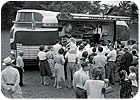
The Futurliners featured large clamshell doors that opened to showcase exhibits.
Parade of Progress
General Motors’ Century of Progress exhibit proved to be so popular that the company decided to take the show on the road in 1936. The Parade of Progress was a world’s fair on wheels that traveled from town to town like a circus in large red and white streamlined trucks.The road show toured Canada and the United States, starting in the southeast in the spring and ending up in the northwest in the fall. The Parade of Progress appeared at numerous states fairs and made special stops in towns where GM had a large number of employees, such as Anderson, IN; Buffalo, NY; Dayton, OH; Flint, MI; and Oshawa, ON. It also made appearances in Cuba and Mexico.
Tents, bleacher seats, exhibits and other equipment were transported in a fleet of 20 support vehicles comprised of Chevrolet and GMC tractor trailers. While in transit, the caravan stretched out for almost 2 miles.
Whenever the vehicles arrived in a new town, they paraded single-file down mainstreet, often with the local high school marching band, just like an old-fashioned circus. The vehicles would end up in a park where a large tent would be erected and the displays would be open, free-of-charge to the public.
Some of the “modern marvels” on display included streamlined locomotives, jet engines, microwave ovens, and sound waves that traveled on a flashlight beam. Another highlight was the Fisher Body Craftsman’s Guild competition, an automotive design contest in which teenagers competed for college scholarships by designing and building scale model dream cars. The Parade of Progress showcased the winners.
In 1941, the Parade of Progress toured with a new fleet of 12 streamlined trucks dubbed Futurliners. Drivers sat in a bubbletop canopy situated on the roof of the vehicle, 8-feet above the ground. The red, silver and white bodies of the 33-foot-long bus-like vehicles featured clamshell doors that opened to provide a stage and a canopy for exhibits that were housed on both sides of the trucks. Light towers rose out of the rooftops and illuminated the exhibits at night.
One of the most popular exhibits was called “Our American Crossroads.” A 16-foot-wide animated diorama demonstrated the transformation of a fictional rural community through 50 years of progress. The 14-minute presentation of synchronized sound and light explained how the automobile positively changed the face of America. Thanks to a complex series of motors, gears, drive chains, conveyors, weights and counter-balances, the elaborate scenery shifted several different times during the show.
Live lecturers and automated “robophones” provided commentary on all the exhibits housed in the Futurliners. In addition, a large aerodome tent could hole 1,250 spectators for a 40-minute stage show that highlighted recent advances in aviation, chemistry, electronics, manufacturing engineering and physics. It included spectacular laboratory experiments and dramatic demonstrations.
The Parade of Progress was halted during World War II, but it resumed in 1953. The last tour occurred in 1956. Ironically, it was made obsolete by one of the technologies that it had showcased in previous years: television.
The Futurliners were sold off and used in various capacities. One of the vehicles was recently restored to its 1953 condition by a group of volunteers in Beaverdam, MI. It’s on display at the National Automotive and Truck Museum (Auburn, IN).
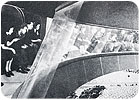
At the 1939 New York World's Fair, visitors to GM's pavilion were transported into the future in "sound chairs" that were attached to a conveyor.
World of Tomorrow
In 1939 and 1940, New York City held a large world’s fair in Flushing Meadow, Queens, with the theme “The World of Tomorrow.” The 7-acre General Motors Pavilion, designed by legendary architect Albert Kahn, was one of the most popular sights at the fair. In addition to showcasing various GM products, the pavilion housed a 35,000-square-foot exhibit called Futurama, which was created by industrial designer Norman Bel Geddes.Visitors sat in one of 552 “sound chairs,” which were attached to a moving conveyor that transported them along 1,568 feet of track for an aerial view of the world of 1960. The highlight was Highways and Horizons, a collection of 408 elaborate dioramas that provided a futuristic vision of mile-high skyscrapers, super highways, pristine suburbs, parks and superb urban planning.
The massive display was the largest model ever created. It featured more than 1 million miniature trees; 500,000 buildings; 50,000 scale-model automobiles, of which 10,000 were in actual operation; thousands of multilane highways; snow-capped mountains, rivers, lakes and streams; industrial centers; resort towns; and even an amusement park.
According to a pamphlet hand out to visitors, the display was “a dramatic illustration of how, through continued progress in highway design and construction, the usefulness of the motor car may still be further expanded and the industry’s contributions to prosperity and better living be increased.”
The exhibit emphasized a futuristic highway system “with its seven lanes accommodating traffic at designated speeds of 50, 75 and 100 miles an hour . . . engineered for easy grades and for curves that require no reduction in speed.” Visitors also learned that “the city of 1960 has abundant sunshine, fresh air, fine green parkways, recreational and civic centers-all the result of thoughtful planning and design.” In addition, people were amazed to hear that 38 million cars would be on the road by 1960 (in fact, there were 61 million, almost twice as many as predicted).
Looking back on the exhibit 25 years later, a 9-page article in theGeneral Motors Engineering Journalpraised the conveyor system. It claimed that “the success of the Futurama was due to two main ingredients: the natural curiosity of man to see what the future holds for him, and the provision of a conveyance system for the visitors, not only for the sake of an organized and controlled movement of people but also for the refreshment of the footsore and the weary.”
At the end of the ride, wide-eyed visitors walked outside into a life-size intersection in the city of tomorrow that was filled with a wide variety of GM vehicles. More than 25 million people visited the pavilion. In addition to seeing Futurama, they enjoyed scientific demonstrations in the Casino of Science and viewed a transparent “X-ray car.” The Pontiac sedan sported a body made out of Plexiglas, which was a new material at the time. All screws and fasteners were chrome-plated for dramatic effect.
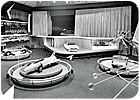
In 1954, crowds packed Motorama to see concept cars such as the Firebird I and the Pontiac Bonneville.
Motorama
During the 1950s, GM staged a series of Motorama displays that combined a mix of jet-age styling, fashion and entertainment. The goal was to showcase exotic new materials, future technology and design trends through the medium of the concept car.The elegant, free-of-charge events featured complex displays, elaborately choreographed Broadway-style shows, and glamorous models parading around in colorful evening gowns that were created to match the show cars. A singing group called the Motor-Rhythms provided a musical backdrop to the extravaganzas. More than 125 tractor-trailer rigs were used to move the exhibits around the country.
When the first Motorama opened in January 1953 in the grand ballroom of the Waldorf-Astoria Hotel in New York City, attendees were wowed by dream cars such as a turquoise-colored OldsmobileStarfire X-P Rocket convertible that featured a wraparound windshield. Another popular vehicle was a black BuickWildcat, which was described as a “revolutionary sports convertible with a Fiberglas body.”
After a one-week stay in New York, the show played to packed ballrooms and convention centers in Miami, Los Angeles, San Francisco, Dallas and Kansas City. In subsequent years, Motorama also made stops in Boston and Chicago.
The 1953 show, which made cars the stars, was a resounding success. In fact, one of the vehicles on display, a 2-seat sportscar from Chevrolet called theCorvette, was so popular that GM decided to send it into production immediately. The Motorama idea proved to be worth the investment. It brought a tremendous amount of attention to the automaker and, after a two-year decline, sales of GM cars soared in 1953.
In subsequent years, the Motorama road show became bigger and better. By 1956, more than 2 million people attended the event in the five cities that it visited. At the New York show alone, GM received $1.3 million in orders for its cars.
The Motorama shows also featured more than just cars. For instance, GM’s Frigidaire Div. amazed the public with its “kitchen of tomorrow.” Displays included an experimental dishwasher that cleaned by sound waves and a marble-topped range that cooked with induction coils that never got hot.
When the 1956 Motorama, which most observers claim was the greatest of them all, began its 4-month coast-to-coast run at the Waldorf-Astoria, crowds packed the ballroom to see futuristic concept cars such as the BuickCenturionand the PontiacBonneville. But, the star of the event was the exoticFirebird II.
The vehicle was described as “the first American gas turbine passenger car specifically designed for family use on the highway.” The 4-seat, titanium-bodiedFirebird IIwas envisioned for use on futuristic electronic highways in which direction, speed and spacing interval would be automatically controlled by computers and radar. According to GM engineers, electronic-impulse-emitting metal strips embedded in the “Auto-Way” road surface would communicate with electronic pick-up coils placed inside a pair of cone-like projections on the front of theFirebird II.
The last Motorama took place in 1961. By then, the event had become too expensive to stage. General Motors was also giving away too many valuable design ideas to its competitors. The increasing popularity of television was another culprit; advertising proved to be a more cost-effective medium.
More than 10 million people attended the shows during the 1950s. “The level of showmanship that characterized the GM Motoramas will likely never be surpassed,” claims Tracy Powell, author ofGeneral Motors Styling 1927-1958. “It was a masterful way to showcase new models and get customers in the showrooms.”

The dump bed of a 50-ton Euclid hauler was turned into a swimming pool during the Powerama show in 1955.
Powerama
Based on the popularity of its Motorama shows, GM decided to hold a grittier version called Powerama. The free-of-charge outdoor show was held in September 1955 along Chicago’s lakefront in Grant Park. The 26-day event showcased how diesel engine technology was used to power trucks, tractors, ships, trains, cranes, military equipment, sawmills, oil wells and other large machinery.General Motors used the 20-acre show to celebrate its role as the world’s largest manufacturer of diesel engines. The $7 million extravaganza was described in the press as a “diesel opera” set in “rainbow-colored Dieseland.”
During the unique event, the dump bed of the world’s biggest dump truck, a 50-ton Euclid hauler, was turned into a swimming pool. Women dove off the roof of the truck and splashed into 4 feet of water.
Other attractions included French acrobats performing from a 70-foot tall crane and 35-ton bulldozers doing the mambo. Visitors packed a 7,000-seat grandstand to watch an hour-long musical entitled “More Power to You.” One of the highlights was a top-hatted elephant that performed a test of strength with a diesel tractor.
The show grounds featured numerous diesel-powered vehicles, ranging from a World War II submarine and a 63-foot-long shrimp boat to an 85-ton atomic cannon. Another one-of-a-kind exhibit was a 15-in. solar-powered car developed by a GM engineer. It used 12 selenium photoelectric cells to power a tiny electric motor that was connected to a driveshaft.
Thanks to GM, diesel power ruled the rails by the mid-1950s. Diesel locomotives, many built by the company’s Electro-Motive Div., hauled 86 percent of all rail passengers and 84 percent of all freight in the United States.
One of the most popular displays at Powerama was theAerotrain. The 10-car, 400-passenger “train of tomorrow” featured streamlined aluminum car bodies that were based on inter-city bus shells. It used an air-cushioned suspension system, a wraparound windshield and stylized tailfins that resembled the rear end of a ChevyNomadstation wagon.
General Motors boasted that each car was twice as light and less than half as expensive than traditional passenger cars. A 1,200-hp diesel engine propelled the train at an average speed of 100 miles per hour.
TheAerotrainwas introduced at a time when U.S. passenger train revenue was steadily declining due to heavy competition from airplanes and automobiles. American railroads were losing more than $700 million annually. Several companies, including the New York Central, the Pennsylvania and the Union Pacific, actually put the trains in service for several years.
More than 2 million Powerama visitors also explored a state-of-the-art E-8 locomotive from Electro-Motive, which was based in nearby LaGrange, IL. The demonstrator unit let people get an up-close view of a 2,250-hp passenger diesel in operation.
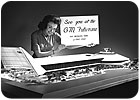
The GM pavilion was one of the largest exhibits at the 1964 New York World's Fair.
Futurama
When New York hosted another world’s fair in 1964 and 1965, GM returned with an updated version of Futurama. But, this time, the 15-minute ride into the future featured a trip around the world “demonstrating what life might be like in coming decades.”
Futurama II visitors sat three abreast as they rode past six detailed dioramas that were carefully synchronized with a sound system. The displays depicted life in outer space, the Antarctic, the ocean floor, the jungle and the desert. Scenic backdrops were painted by artists from Metro-Goldwyn-Mayer.
At each section of the exhibit, visitors witnessed GM’s “machines of tomorrow” at work. For instance, in the jungle, a self-propelled road builder, described as “a factory on wheels,” was joined by two machines that cleared trees with laser beams.
The road builder was fully automated. According to a contemporary press release, “it levels the ground, sets stanchions, casts and places the road-surface slabs, and links each unit into the highway which emerges in its wake. Follow-up vehicles install lighting, traffic control and railings to complete the express highway.” The release went on to proclaim that “the road-builder brings more than a highway to the jungle; it brings progress and prosperity as well.”
The exhibit also portrayed lunar colonies, remote-controlled farms in the desert, plastic domes for arctic climate control, underwater hotels and atomic-powered submarine trains. At the end of the tour around the futuristic world, visitors encountered a city of tomorrow, which featured computer-controlled highways, glass skyscrapers, moving sidewalks and atomic generators.
The Futurama II ride followed a closed-loop track that ran 1,850 feet while moving through several different elevations. The conveyor-based system, designed by GM engineers, could accommodate 65,000 visitors a day. They developed a vertical belt friction drive system, including the driveline, brake assemblies and electrical controls.
The 230,000-square-foot General Motors building also included an Avenue of Progress, which featured a Space Age theme. Items on display included a solar space mirror, an articulated lunar vehicle, the world’s largest cosmic-ray spark chamber and exhibits on space navigation technology.
Several futuristic vehicles were also on display, such as the GM-X Stiletto. It featured aircraft-style steering, toggle-switch controls and a 3-way speaker system for interior-exterior communication. Another show-stopper was the aerodynamic Bison Bullet gas turbine truck. It was designed to haul standardized containers and featured electronic loading-unloading equipment.
Today, GM’s show heritage lives on in Orlando, FL. In 1982, the company opened a pavilion at EPCOT Center, Walt Disney’s idea of a permanent world’s fair. The $50 million World of Motion exhibit depicted how transportation and lifestyles would change in the future.
Visitors were whisked away in an audio-equipped chair ride through 24 animated scenes depicting the history of transportation. Another part of the pavilion provided a behind-the-scenes look at GM’s design, engineering and manufacturing facilities. In the late 1990s, the exhibit was remodeled and transformed into a popular thrill-ride called Test Track.
When World Expo 2010 opens in Shanghai, China, in two years, GM will be actively participating. Along with its joint-venture partner, Shanghai Automotive Industry Corp., GM will be sponsoring a large pavilion touting the company’s latest products and production processes.
Futurama II visitors sat three abreast as they rode past six detailed dioramas that were carefully synchronized with a sound system. The displays depicted life in outer space, the Antarctic, the ocean floor, the jungle and the desert. Scenic backdrops were painted by artists from Metro-Goldwyn-Mayer.
At each section of the exhibit, visitors witnessed GM’s “machines of tomorrow” at work. For instance, in the jungle, a self-propelled road builder, described as “a factory on wheels,” was joined by two machines that cleared trees with laser beams.
The road builder was fully automated. According to a contemporary press release, “it levels the ground, sets stanchions, casts and places the road-surface slabs, and links each unit into the highway which emerges in its wake. Follow-up vehicles install lighting, traffic control and railings to complete the express highway.” The release went on to proclaim that “the road-builder brings more than a highway to the jungle; it brings progress and prosperity as well.”
The exhibit also portrayed lunar colonies, remote-controlled farms in the desert, plastic domes for arctic climate control, underwater hotels and atomic-powered submarine trains. At the end of the tour around the futuristic world, visitors encountered a city of tomorrow, which featured computer-controlled highways, glass skyscrapers, moving sidewalks and atomic generators.
The Futurama II ride followed a closed-loop track that ran 1,850 feet while moving through several different elevations. The conveyor-based system, designed by GM engineers, could accommodate 65,000 visitors a day. They developed a vertical belt friction drive system, including the driveline, brake assemblies and electrical controls.
The 230,000-square-foot General Motors building also included an Avenue of Progress, which featured a Space Age theme. Items on display included a solar space mirror, an articulated lunar vehicle, the world’s largest cosmic-ray spark chamber and exhibits on space navigation technology.
Several futuristic vehicles were also on display, such as the GM-X Stiletto. It featured aircraft-style steering, toggle-switch controls and a 3-way speaker system for interior-exterior communication. Another show-stopper was the aerodynamic Bison Bullet gas turbine truck. It was designed to haul standardized containers and featured electronic loading-unloading equipment.
Today, GM’s show heritage lives on in Orlando, FL. In 1982, the company opened a pavilion at EPCOT Center, Walt Disney’s idea of a permanent world’s fair. The $50 million World of Motion exhibit depicted how transportation and lifestyles would change in the future.
Visitors were whisked away in an audio-equipped chair ride through 24 animated scenes depicting the history of transportation. Another part of the pavilion provided a behind-the-scenes look at GM’s design, engineering and manufacturing facilities. In the late 1990s, the exhibit was remodeled and transformed into a popular thrill-ride called Test Track.
When World Expo 2010 opens in Shanghai, China, in two years, GM will be actively participating. Along with its joint-venture partner, Shanghai Automotive Industry Corp., GM will be sponsoring a large pavilion touting the company’s latest products and production processes.
Click GM Centennial: Futuristic Fantasies to view a slideshow of GM concept vehicles from the past, present and future.
